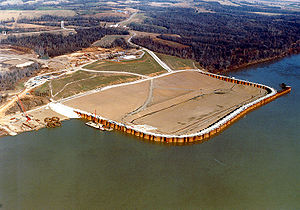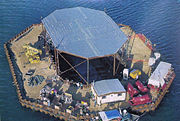
Cofferdam
Encyclopedia


Oil platform
An oil platform, also referred to as an offshore platform or, somewhat incorrectly, oil rig, is a lаrge structure with facilities to drill wells, to extract and process oil and natural gas, and to temporarily store product until it can be brought to shore for refining and marketing...
s, bridge piers and other support structures built within or over water. These cofferdams are usually welded steel structures, with components consisting of sheet piles, wale
Wale
A wale is a broad, thick plank around the outside of a wooden ship.The garboard is the wale next to the keel; the gunwale is the top such plank and covers the heads of the timbers between the main and fore drifts....
s, and cross brace
Timber framing
Timber framing , or half-timbering, also called in North America "post-and-beam" construction, is the method of creating structures using heavy squared off and carefully fitted and joined timbers with joints secured by large wooden pegs . It is commonplace in large barns...
s. Such structures are typically dismantled after the ultimate work is completed.
For dam
Dam
A dam is a barrier that impounds water or underground streams. Dams generally serve the primary purpose of retaining water, while other structures such as floodgates or levees are used to manage or prevent water flow into specific land regions. Hydropower and pumped-storage hydroelectricity are...
construction, two cofferdams are usually built, one upstream and one downstream of the proposed dam, after an alternative diversion tunnel or channel has been provided for the river flow to bypass the dam foundation area. These cofferdams are typically a conventional embankment dam of both earth- and rock-fill, but concrete or some sheet piling also may be used. Typically, upon completion of the dam and associated structures, the downstream coffer is removed and the upstream coffer is flooded as the diversion is closed and the reservoir begins to fill. Dependent upon the geography of a dam site, in some applications, a "U"-shaped cofferdam is used in the construction one half of a dam. When complete, the cofferdam is removed and a similar one is created on the opposite side of the river for the construction of the dam's other half.
The cofferdam is also used on occasion in the shipbuilding and ship repair industry, when it is not practical to put a ship
Ship
Since the end of the age of sail a ship has been any large buoyant marine vessel. Ships are generally distinguished from boats based on size and cargo or passenger capacity. Ships are used on lakes, seas, and rivers for a variety of activities, such as the transport of people or goods, fishing,...
in drydock for repair or alteration. An example of such an application is certain ship lengthening operations. In some cases a ship is actually cut in two while still in the water, and a new section of ship is floated in to lengthen the ship. Torch cutting of the hull
Hull (watercraft)
A hull is the watertight body of a ship or boat. Above the hull is the superstructure and/or deckhouse, where present. The line where the hull meets the water surface is called the waterline.The structure of the hull varies depending on the vessel type...
is done inside a cofferdam attached directly to the hull of the ship, and is then detached before the hull sections are floated apart. The cofferdam is later replaced while the hull sections are welded together again. As expensive as this may be to accomplish, use of a drydock may be even more expensive.
See also caisson
Caisson (engineering)
In geotechnical engineering, a caisson is a retaining, watertight structure used, for example, to work on the foundations of a bridge pier, for the construction of a concrete dam, or for the repair of ships. These are constructed such that the water can be pumped out, keeping the working...
.

USS Maine (ACR-1)
USS Maine was the United States Navy's second commissioned pre-dreadnought battleship, although she was originally classified as an armored cruiser. She is best known for her catastrophic loss in Havana harbor. Maine had been sent to Havana, Cuba to protect U.S. interests during the Cuban revolt...
, or Robert de LaSalle's La Belle
La Belle (ship)
La Belle was one of Robert de La Salle's four ships when he explored the Gulf of Mexico with the ill-fated mission of starting a French colony at the mouth of the Mississippi River in 1685. La Belle was wrecked in present-day Matagorda Bay the following year, dooming La Salle's Texas colony to...
.
A 100 ton open caisson that was lowered more than a mile to the sea floor in attempts to stop the flow of oil in the Deepwater Horizon oil spill
Deepwater Horizon oil spill
The Deepwater Horizon oil spill is an oil spill in the Gulf of Mexico which flowed unabated for three months in 2010, and continues to leak fresh oil. It is the largest accidental marine oil spill in the history of the petroleum industry...
has been called a cofferdam. It did not work as methane froze in the upper levels preventing the containment.
Naval architecture
A cofferdam may also refer to an insulating space between two watertight bulkheadBulkhead (partition)
A bulkhead is an upright wall within the hull of a ship or within the fuselage of an airplane. Other kinds of partition elements within a ship are decks and deckheads.-Etymology:...
s or deck
Deck (ship)
A deck is a permanent covering over a compartment or a hull of a ship. On a boat or ship, the primary deck is the horizontal structure which forms the 'roof' for the hull, which both strengthens the hull and serves as the primary working surface...
s within a ship. A cofferdam may be a void (empty) space or a ballast
Ballast tank
A ballast tank is a compartment within a boat, ship or other floating structure that holds water.-History:The basic concept behind the ballast tank can be seen in many forms of aquatic life, such as the blowfish or argonaut octopus, and the concept has been invented and reinvented many times by...
space. Cofferdams are usually employed to ensure oil or other chemicals do not leak into machinery spaces. If two different cargoes that react dangerously with each other are carried on the same vessel, one or more cofferdams are usually required between the cargo spaces.
The division between the tanks and the hull of a double-hulled vessel is not normally called a cofferdam, although it serves this function.

